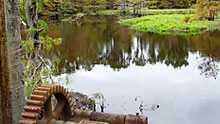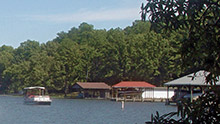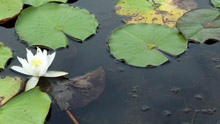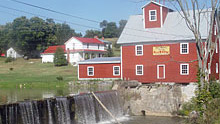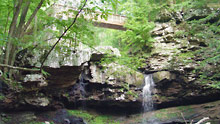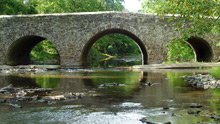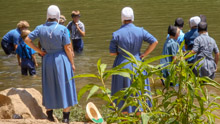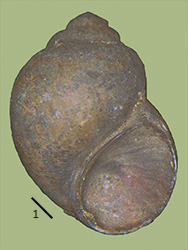> Habitat & Distribution
Thompson (1968) mapped N. wetherbyi populations extending across central Florida, from the St. Johns River system to the lower Suwanee, adding scattered records from the Florida panhandle, the lower Chattahoochee drainage of Georgia, and south Alabama. He gave their habitat as "springs, spring runs, streams and lakes, generally found buried in sand that is devoid of vegetation." FWGNA incidence unranked.
> Ecology & Life History
Notogillia wetherbyi is unusually large-bodied by hydrobiid standards, adults bearing surprisingly heavy shells up to 7.8 mm max dimension. In overall morphology, their resemblance to juvenile Campeloma decisum is striking. Occasionally found burrowing in clean sand side-by-side, apparently harvesting the same resources, the convergence between the hydrobiid Notogillia wetherbyi and the viviparid Campeloma decisum is one of the more dramatic demonstrations that shell morphology may correlate with ecological niche in the freshwater gastropods (Dillon 1981).
Hydrobiids are typically dioecious; the males being characterized by a penis that arises from the neck, females typically attaching single eggs in spare, hemispherical capsules to solid substrates (Hershler 1994). No specific life history data are as yet available for N. wetherbyi.
> Taxonomy & Systematics
William Healy Dall (1885) described Hydrobia wetherbyi from Lake Eustis, one of the many lakes of Central Florida draining east into the St. Johns system. The species was segregated into the new genus Notogillia by Pilsbry (1953).
In overall morphology the penis of Notogillia is typically nymphophiline, spatulate or blade-shaped with surficial glandular patterns (Kabat and Hershler 1993). The genus was retained, along with such other nymphophiline genera as Marstonia, Floridobia, and Pyrgulopsis, in the new, pared-down Hydrobiidae (ss) by Wilke and colleagues (2013).
Notogillia wetherbyi DNA sequences CO1, 16s and 18s have been included in three gene tree analyses to date (Wilke et al. 2001, Hershler et al. 2003, Wilke et al. 2013). In general, the closest evolutionary relationships seem to be with Spilochlamys and Cincinnatia.
> Maps and Supplementary Resources
> Essays
- Earlier versions of this website, online until August of 2016, adopted the large, broadly-inclusive concept of the Hydrobiidae (sl) following Kabat & Hershler (1993). More recently the FWGNA project has shifted to the Wilke et al. (2013) classification system, distinguishing a much smaller Hydrobiidae (ss) and elevating many hydrobioid taxa previously ranked as subfamilies to the full family level. For more details, see The Classification of the Hydrobioids.
> References
Dall, W. H. (1885) Notes on some Floridian land and fresh-water shells with a revision of the Auriculacea of the eastern United States. Proceedings of the US National Museum 8: 255 289.
Dillon, R.T., Jr. (1981) Patterns in the morphology and distribution of gastropods in Oneida Lake, New York, detected using computer-generated null hypotheses. American Naturalist 118: 83-101. [PDF]
Dillon, R. T., Jr. (2000) The Ecology of Freshwater Molluscs. Cambridge, Cambridge University Press. 509 pp.
Hershler, R. (1994) A review of the North American freshwater snail genus Pyrgulopsis (Hydrobiidae). Smithsonian Contributions to Zoology 554:1-115.
Hershler, R., H. Liu, and F.G. Thompson (2003) Phylogenetic relationships of North American nymphophiline gastropods based on mitochondrial DNA sequences. Zoologica Scripta 32:357-366.
Kabat, A.R., and R. Hershler (1993) The prosobranch snail family Hydrobiidae (Gastropoda: Rissooidea): review of classification and supraspecific taxa. Smithsonian Contributions to Zoology 547:1-94.
Pilsbry, H. A. (1953) Monographs of the Academy of Natural Sciences of Philadelphia 8: 440.
Thompson, F.G. (1968) The Aquatic Snails of the Family Hydrobiidae of Peninsular Florida. University of Florida Press, Gainesville, Florida, USA.
Thompson, F.G. (1969) Some hydrobiid snails from Georgia and Florida. Quarterly Journal of the Florida Academy of Sciences 32:241-265.
Thompson, F.G. (1999) An identification manual for the freshwater snails of Florida. Walkerana 10: 1 96.
Watson, C. N. (2000) Results of a survey for selected species of Hydrobiidae (Gastropoda) in Georgia and Florida. pp. 233 - 244 in Freshwater Mollusk Symposium Proceedings (Tankersley et al, eds) Ohio Biological Survey, Columbus.
Wilke, T., G.M. Davis, A. Falniowski, F. Giusti, M. Bodon, and M. Szarowska (2001) Molecular systematics of Hydrobiidae (Mollusca: Gastropoda: Rissooidea): testing monophyly and phylogenetic relationships. Proceedings of the Academy of Natural Sciences of Philadelphia 151: 1 21.
Wilke T., Haase M., Hershler R., Liu H-P., Misof B., Ponder W. (2013) Pushing short DNA fragments to the limit: Phylogenetic relationships of hydrobioid gastropods (Caenogastropoda: Rissooidea). Molecular Phylogenetics and Evolution 66: 715 736.

